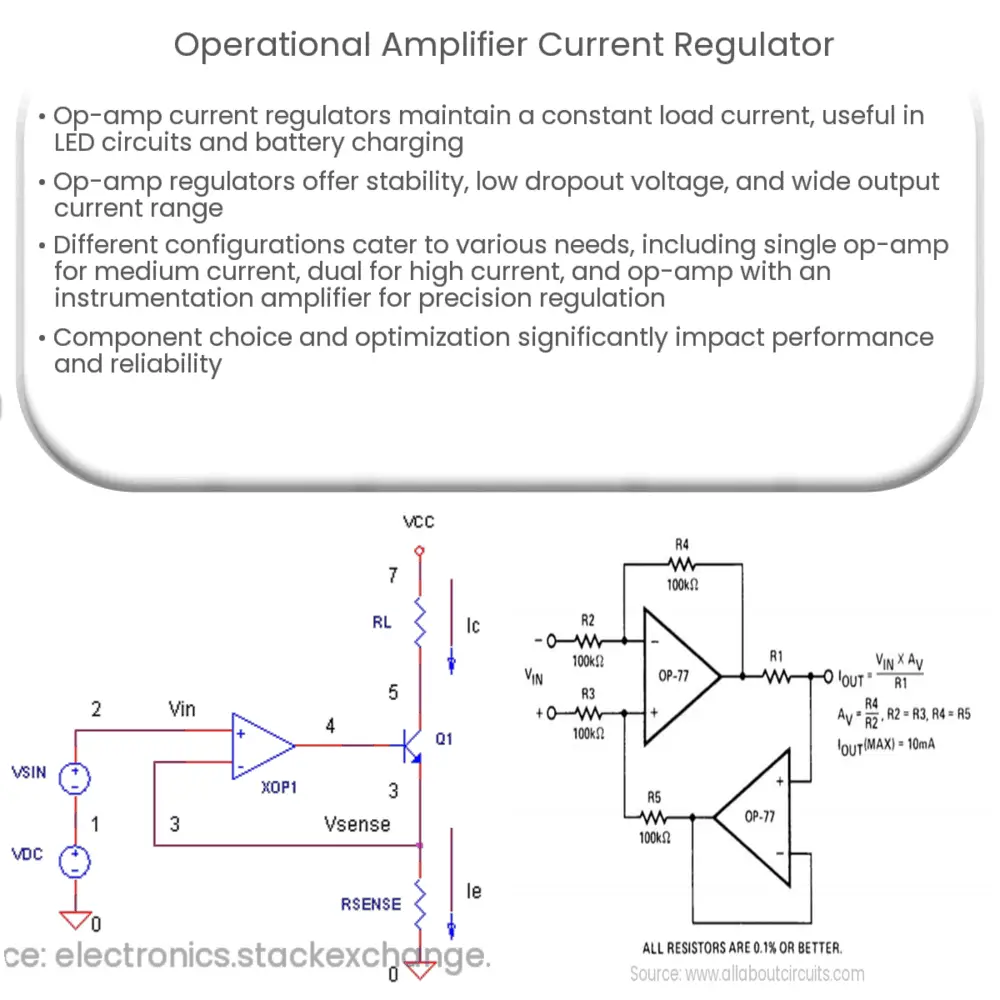An op-amp current regulator maintains constant current in a circuit, offering stability, accuracy, and efficiency in various applications.

Operational Amplifier Current Regulator
An operational amplifier (op-amp) is a versatile electronic component that can be used in a wide range of applications, such as amplifying weak signals, filtering signals, and performing mathematical operations. One lesser-known application of op-amps is as a current regulator, which can be particularly useful in maintaining a constant current through a load, regardless of fluctuations in supply voltage or load resistance.
Why Use an Op-Amp as a Current Regulator?
Current regulators are critical in circuits where a stable current is required for proper operation. For instance, in light-emitting diode (LED) circuits, a stable current prevents fluctuations in brightness and extends the life of the LED. In battery charging applications, a constant current maintains the optimal charging rate and prevents overcharging. An op-amp-based current regulator offers several advantages over other types of current regulators, such as improved stability, low dropout voltage, and the ability to control a wide range of output currents.
Basic Operation of an Op-Amp Current Regulator
An op-amp-based current regulator typically consists of an op-amp, a reference voltage source, a sense resistor, and a pass transistor. The op-amp is configured as a voltage-to-current converter, which controls the gate or base voltage of the pass transistor. The pass transistor is responsible for providing the necessary current to the load, while the sense resistor measures the load current.
When the load current increases, the voltage across the sense resistor rises, causing the non-inverting input of the op-amp to increase. The op-amp, in turn, adjusts the gate or base voltage of the pass transistor, reducing the current flowing through it. This negative feedback mechanism ensures that the current remains constant, despite changes in load resistance or supply voltage.
Common Op-Amp Current Regulator Configurations
There are several configurations that can be used to build an op-amp current regulator, depending on the specific requirements of the application. Some of the most common configurations include:
- Single Op-Amp Current Regulator: This configuration uses a single op-amp and an NPN or PNP bipolar transistor or a MOSFET as the pass transistor. It is suitable for low to medium current applications, up to a few hundred milliamps.
- Dual Op-Amp Current Regulator: In this configuration, two op-amps are used, one for current sensing and the other for current control. This arrangement offers improved stability and lower dropout voltage compared to the single op-amp configuration. It is suitable for higher current applications, up to several amps.
- Op-Amp and Instrumentation Amplifier Current Regulator: This configuration combines an op-amp with an instrumentation amplifier for enhanced current sensing accuracy. It is suitable for precision current regulation applications, such as battery charging or LED lighting.
Selecting the Right Components for Your Op-Amp Current Regulator
When designing an op-amp current regulator, it is crucial to choose the right components to ensure optimal performance and reliability. Some important factors to consider when selecting components include:
- Op-Amp Characteristics: Choose an op-amp with a low input offset voltage and low input bias current to minimize errors in the current regulation. Also, consider the op-amp’s slew rate and bandwidth to ensure a fast response to changes in load conditions.
- Pass Transistor: Select a pass transistor with a high current rating and low on-resistance to minimize power loss and maximize efficiency. For high-power applications, consider using a power transistor with a heatsink to manage thermal dissipation.
- Reference Voltage: A stable and precise reference voltage is essential for accurate current regulation. Consider using a precision voltage reference or a zener diode with a low temperature coefficient for improved stability.
- Sense Resistor: The sense resistor should have a low temperature coefficient and a power rating sufficient to handle the maximum load current. A precision, low-drift resistor is recommended for high-accuracy applications.
Troubleshooting and Optimization Tips
When implementing an op-amp current regulator, it is essential to evaluate its performance and make any necessary adjustments to achieve the desired current regulation. Some common issues and optimization tips include:
- Stability Issues: If the current regulator oscillates or exhibits poor transient response, consider adding a compensation capacitor across the feedback path to improve stability. Also, verify that the op-amp’s slew rate and bandwidth are adequate for the application.
- Accuracy Issues: If the current regulation is not as accurate as desired, check for errors in component values, particularly the sense resistor and reference voltage. Consider using higher-precision components or calibrating the circuit to compensate for component tolerances.
- Thermal Issues: If the pass transistor or sense resistor becomes excessively hot, ensure that their power ratings are sufficient for the load current. Consider using a heatsink or a fan to improve thermal management.
Conclusion
An operational amplifier current regulator is a versatile and efficient solution for maintaining a constant current through a load in various applications. By carefully selecting the appropriate components and optimizing the circuit design, an op-amp current regulator can provide excellent performance, stability, and accuracy. Whether you are designing a battery charger, LED driver, or any other application requiring stable current regulation, an op-amp-based current regulator is a valuable tool to consider.

